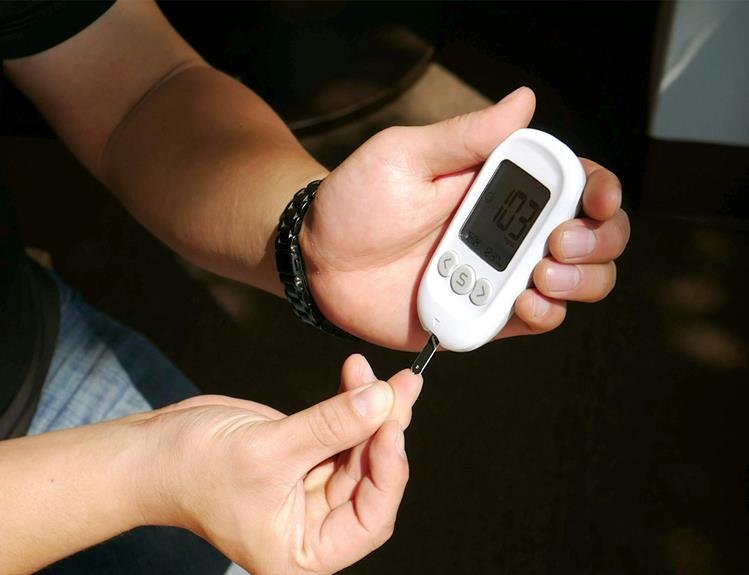The Role of Diet and Exercise in Preventing Diabetes-Related Amputations
Did you know that approximately 60% of non-traumatic lower-limb amputations worldwide are related to diabetes? Maintaining a healthy diet and incorporating regular exercise into your routine can play a crucial role in preventing such drastic consequences.
By making simple yet impactful changes to your lifestyle, you can significantly reduce the risk of diabetes-related amputations. Let's explore how diet and exercise can be your allies in this important journey towards better health.
Importance of Diet in Diabetes Prevention
To prevent diabetes and its related complications, maintaining a healthy diet is crucial. Your dietary choices play a significant role in managing blood sugar levels, reducing the risk of developing diabetes, and ultimately preventing diabetes-related amputations. By focusing on a balanced diet rich in fruits, vegetables, whole grains, lean proteins, and healthy fats, you can help regulate your blood glucose levels and maintain a healthy weight.
Limiting the intake of sugary beverages, processed foods high in refined sugars and fats, and excessive amounts of carbohydrates is essential in diabetes prevention. These foods can lead to spikes in blood sugar levels, increasing the strain on your body's insulin production and potentially contributing to the development of diabetes over time.
Make sure to monitor your portions, eat regular meals, and stay hydrated throughout the day. By being mindful of what you eat and making healthy choices, you can significantly lower your risk of diabetes and the associated complications, including the need for amputations.
Impact of Exercise on Amputation Risk
Regular exercise can improve circulation, which is crucial for preventing complications in diabetic patients. Strength training can also help build muscle mass and improve overall physical function, reducing the risk of amputations.
Exercise and Circulation
Engaging in consistent physical activity can significantly improve circulation, reducing the risk of amputations in individuals with diabetes. Exercise helps to keep blood flowing efficiently throughout your body, promoting healthy blood vessels and preventing blockages that can lead to serious complications.
By increasing blood flow, exercise ensures that essential nutrients and oxygen reach your extremities, reducing the likelihood of tissue damage and infection. Improved circulation also aids in wound healing, crucial for individuals with diabetes who are at a higher risk of developing foot ulcers.
Regular exercise, such as walking, swimming, or cycling, can make a notable difference in maintaining healthy blood flow and reducing the chances of amputations in diabetic individuals.
Strength Training Benefits
Incorporating strength training into your exercise routine can play a pivotal role in reducing the risk of amputations for individuals with diabetes. By engaging in activities like weightlifting or resistance exercises, you can improve muscle mass, enhance circulation, and boost overall strength.
Strong muscles help support your joints and bones, reducing the likelihood of injuries that could lead to amputation. Additionally, strength training can improve your body's ability to manage blood sugar levels, reducing the risk of complications that may necessitate amputation.
Aim to include strength training exercises at least two to three times a week, focusing on major muscle groups. Consult with a healthcare provider or a fitness professional to design a safe and effective strength training program tailored to your needs.
Key Nutritional Strategies for Diabetics
What're some essential dietary guidelines for managing diabetes effectively? Maintaining stable blood sugar levels is crucial for diabetics.
Focus on a well-balanced diet that includes plenty of fruits, vegetables, whole grains, lean proteins, and healthy fats. Limit your intake of sugary foods, refined carbohydrates, and saturated fats that can spike blood sugar levels.
Opt for high-fiber foods like beans, legumes, and oats to help regulate blood glucose levels. Stay hydrated by drinking plenty of water throughout the day.
Be mindful of portion sizes to avoid overeating, which can lead to blood sugar imbalances. Monitor your carbohydrate intake and spread it evenly throughout the day to prevent sudden spikes or drops in blood sugar.
Consider working with a registered dietitian to create a personalized meal plan tailored to your specific needs. By following these key nutritional strategies, you can better manage your diabetes and reduce the risk of complications.
Effective Workouts for Diabetes Management
Regular physical activity plays a crucial role in effectively managing diabetes and improving overall health. When it comes to choosing workouts for diabetes management, focus on a combination of aerobic exercises and strength training.
Aerobic exercises like brisk walking, cycling, or swimming help lower blood sugar levels and improve insulin sensitivity. Aim for at least 150 minutes of moderate-intensity aerobic activity each week, spread out over several days.
Additionally, incorporate strength training exercises using resistance bands, weights, or bodyweight exercises like squats and lunges to build muscle and improve blood sugar control.
Interval training, which involves alternating between high-intensity bursts of activity and periods of rest, can also be beneficial for managing diabetes. This type of workout can help increase cardiovascular fitness and better regulate blood sugar levels.
Remember to consult with your healthcare provider before starting any new workout regimen, especially if you have existing health concerns. Stay consistent with your workouts and listen to your body to reap the full benefits of exercise in diabetes management.
Role of Weight Management in Prevention
When it comes to preventing diabetes-related amputations, managing your weight is crucial.
You should pay attention to your BMI, aim for a dietary caloric balance, and meet physical activity recommendations.
These factors play a significant role in reducing the risk of complications associated with diabetes.
Importance of BMI
Maintaining a healthy BMI through effective weight management plays a crucial role in preventing diabetes-related amputations. Having a BMI within the recommended range can significantly reduce the risk of complications associated with diabetes, such as nerve damage and poor circulation, which can lead to amputations.
By keeping your weight in check, you can help control your blood sugar levels, lower your blood pressure, and decrease the strain on your feet and lower limbs. Excess weight puts extra stress on the body and can exacerbate diabetes symptoms, making it harder to manage the condition effectively.
Dietary Caloric Balance
Effective weight management through maintaining a healthy dietary caloric balance is essential in preventing diabetes-related amputations. Consuming more calories than your body needs can lead to weight gain, increasing the risk of diabetes complications.
To achieve a caloric balance, focus on eating nutrient-dense foods like fruits, vegetables, whole grains, and lean proteins while limiting overly processed and high-sugar items. Portion control is key; be mindful of serving sizes to prevent overeating.
Monitoring your caloric intake can help you maintain a healthy weight, reducing the strain on your body and decreasing the chances of developing complications like neuropathy or poor wound healing. By managing your dietary caloric balance, you take a crucial step towards preventing diabetes-related amputations.
Physical Activity Recommendations
To prevent diabetes-related amputations, it's crucial to incorporate physical activity into your routine as a key component of weight management. Aim for at least 150 minutes of moderate-intensity aerobic exercise per week, such as brisk walking or swimming, spread out over several days.
Additionally, include strength training exercises involving major muscle groups on two or more days a week. These activities can help improve insulin sensitivity, lower blood sugar levels, and aid in weight loss or maintenance.
Remember to start slowly and gradually increase the intensity and duration of your workouts to avoid injury. Consult with a healthcare provider before starting any new exercise program, especially if you have existing health conditions.
Consistent physical activity is essential for managing weight and reducing the risk of diabetes-related complications like amputations.
Monitoring Blood Sugar Levels Effectively
Regularly checking your blood sugar levels is crucial for managing diabetes and preventing complications such as amputations. Monitoring your blood sugar effectively involves using a glucose meter to measure your levels multiple times a day. It's recommended to check before meals, after meals, before and after exercise, and before bedtime to get a comprehensive understanding of how different factors affect your blood sugar.
Consistency is key when it comes to monitoring your blood sugar levels. Keeping a log of your readings can help you and your healthcare provider identify patterns and make necessary adjustments to your diabetes management plan. Additionally, understanding the target range for your blood sugar levels and knowing when to seek medical attention if your levels are consistently out of range is essential for preventing complications.
Remember to follow the instructions provided with your glucose meter for accurate readings. If you have any concerns about your blood sugar levels or are unsure about how to interpret your readings, don't hesitate to reach out to your healthcare team for guidance and support.
Frequently Asked Questions
Can Diabetes-Related Amputations Be Completely Prevented Through Diet and Exercise?
You can significantly reduce the risk of diabetes-related amputations through a healthy diet and regular exercise. While complete prevention may not always be possible, these lifestyle choices can greatly improve your overall health.
How Do Genetics Play a Role in the Development of Diabetes-Related Amputations?
Genetics can influence your risk of diabetes-related amputations. Certain genes may make you more susceptible to complications. Understanding your genetic predisposition can help tailor preventive strategies alongside diet and exercise to mitigate these risks effectively.
Are There Any Specific Dietary Supplements That Can Help in Preventing Amputations in Diabetics?
To prevent amputations in diabetics, focus on a balanced diet rich in fruits, vegetables, and whole grains. Regular exercise, like walking or swimming, can also help. Consult a healthcare provider for personalized advice.
How Can Mental Health and Stress Management Impact the Effectiveness of Diet and Exercise in Preventing Diabetes-Related Amputations?
Managing stress and mental health is key. When stressed, cortisol levels rise, affecting blood sugar control. This can hinder the benefits of diet and exercise in preventing diabetes-related amputations. Prioritize your well-being for better outcomes.
What Are Some Alternative Exercise Options for Individuals With Mobility Limitations Due to Diabetes Complications?
If you have mobility limitations due to diabetes complications, consider swimming, chair yoga, or resistance band exercises as alternative options. These activities can help improve your strength and flexibility while being gentle on your joints.
Conclusion
So, as you can see, maintaining a healthy diet and exercise routine are crucial in preventing diabetes-related amputations.
By following key nutritional strategies, engaging in effective workouts, and managing your weight, you can significantly reduce your risk.
Remember, monitoring your blood sugar levels is also essential in staying healthy and preventing complications.
Stay tuned for more tips and tricks on how to take control of your diabetes and live a happy, active life.






